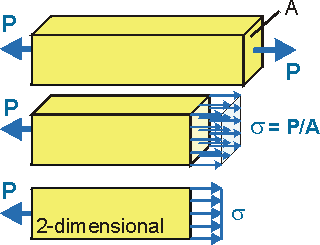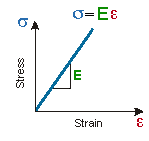Axial Strain | Axial Stress | s-e Curve | Young's Modulus | Poisson's Ratio | Elastic Strain Energy | Fatigue



| 3.1 Normal (Axial) Stress and Strain
Axial Strain | Axial Stress | s-e Curve | Young's Modulus | Poisson's Ratio | Elastic Strain Energy | Fatigue |


 |
|
» Axial Stress
|
 |
|
|
||
|
» Stiffness; Young's Modulus
Where E is the YOUNG'S MODULUS or stiffness of the material. Values of E for different materials are obtained experimentally from stress-strain curves. Young's Modulus is simply the slope of the linear region of the stress-strain curve. Values of Young's Modulus for various materials are given in Table 1 - Elastic Constants. Young's Modulus is generally large and usually expressed in either Msi (megapounds per square inch = thousands of ksi) or GPa (gigapascal). |
 |
|
» Stress-Strain Curve |
|
|
|
•Proportional Limit: the value of stress
when the stress-strain curve no longer follows Hooke's Law. |
||
|
» Poisson's Ratio
Typical values of Poisson's Ratio for various materials are given in Table 1 - Elastic Constants. |
|
» Elastic Strain Energy Density
The maximum value of the elastic strain energy is the RESILIENCE. It occurs when the stress in the axial member reaches the yield strength:
|
|
» Fatigue The fatigue strength of a material is the value of the stress amplitude for a given value of Nf can be calculated:
Typically, for steel, Nf = 106 cycles and for aluminum Nf = 107 cycles. Steels also have a fatigue limit... |
|

|



|